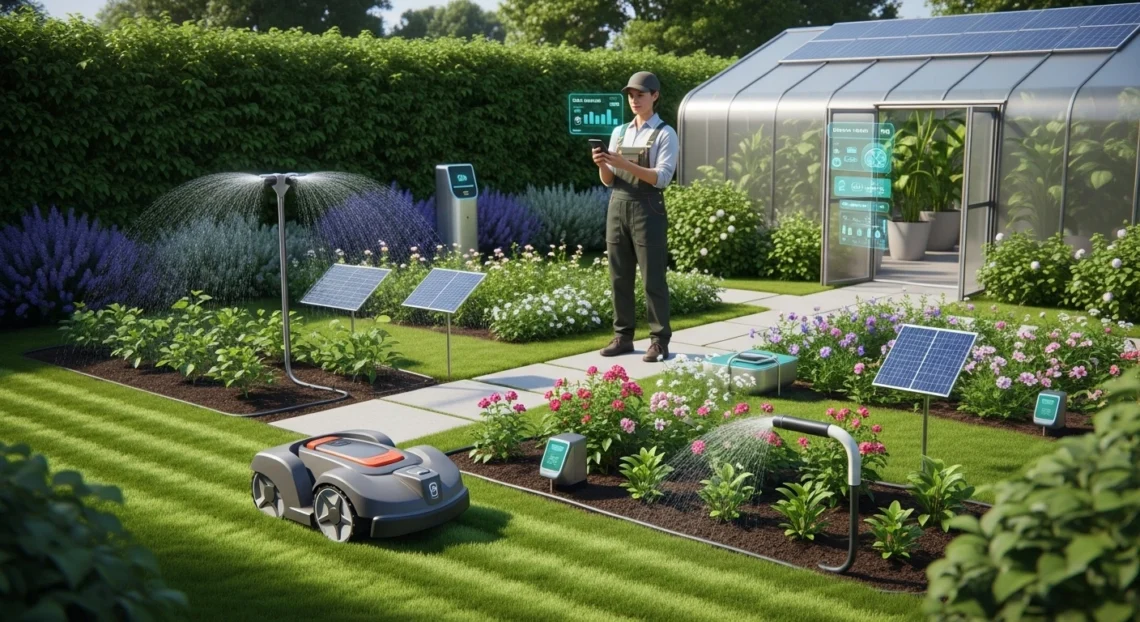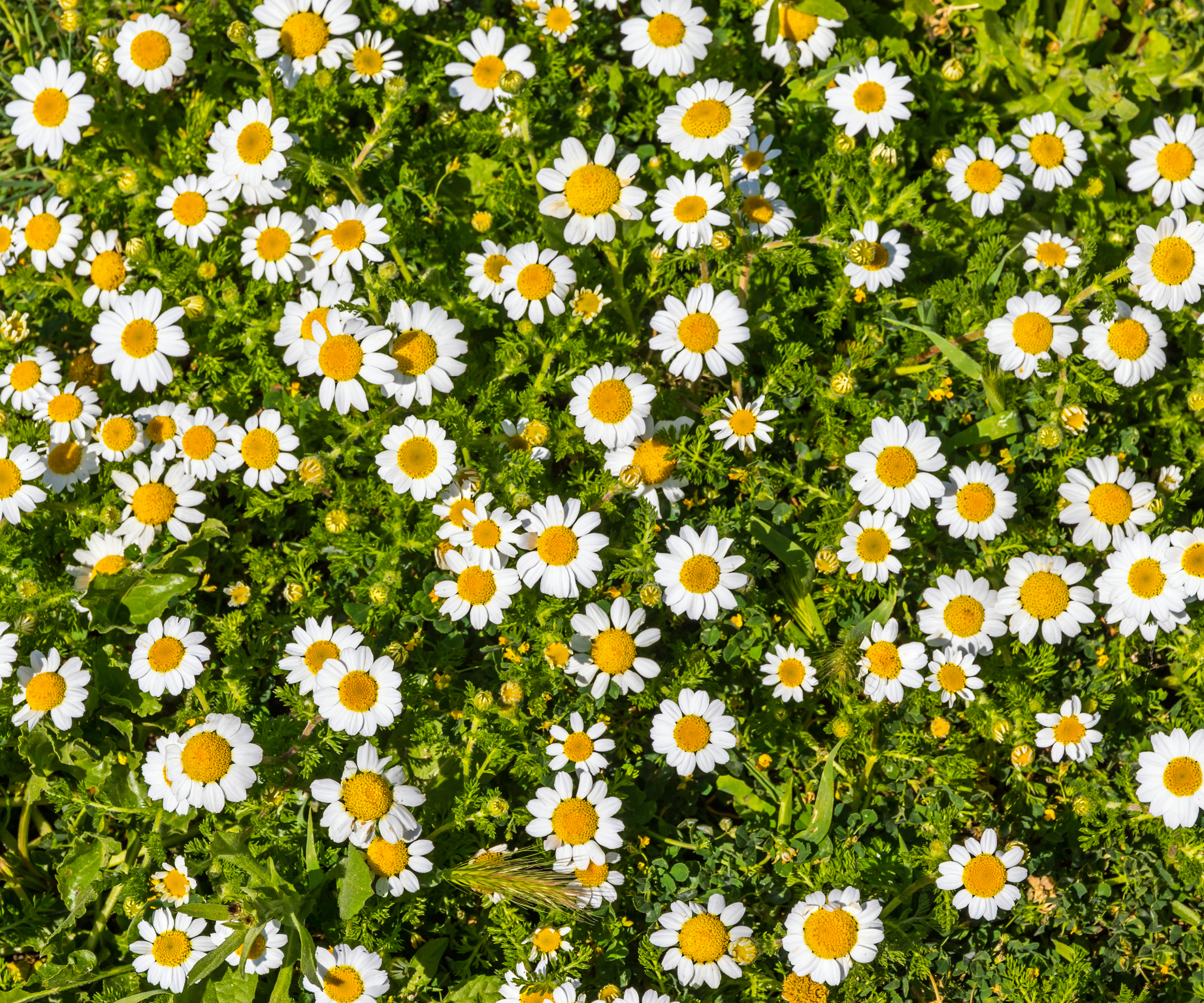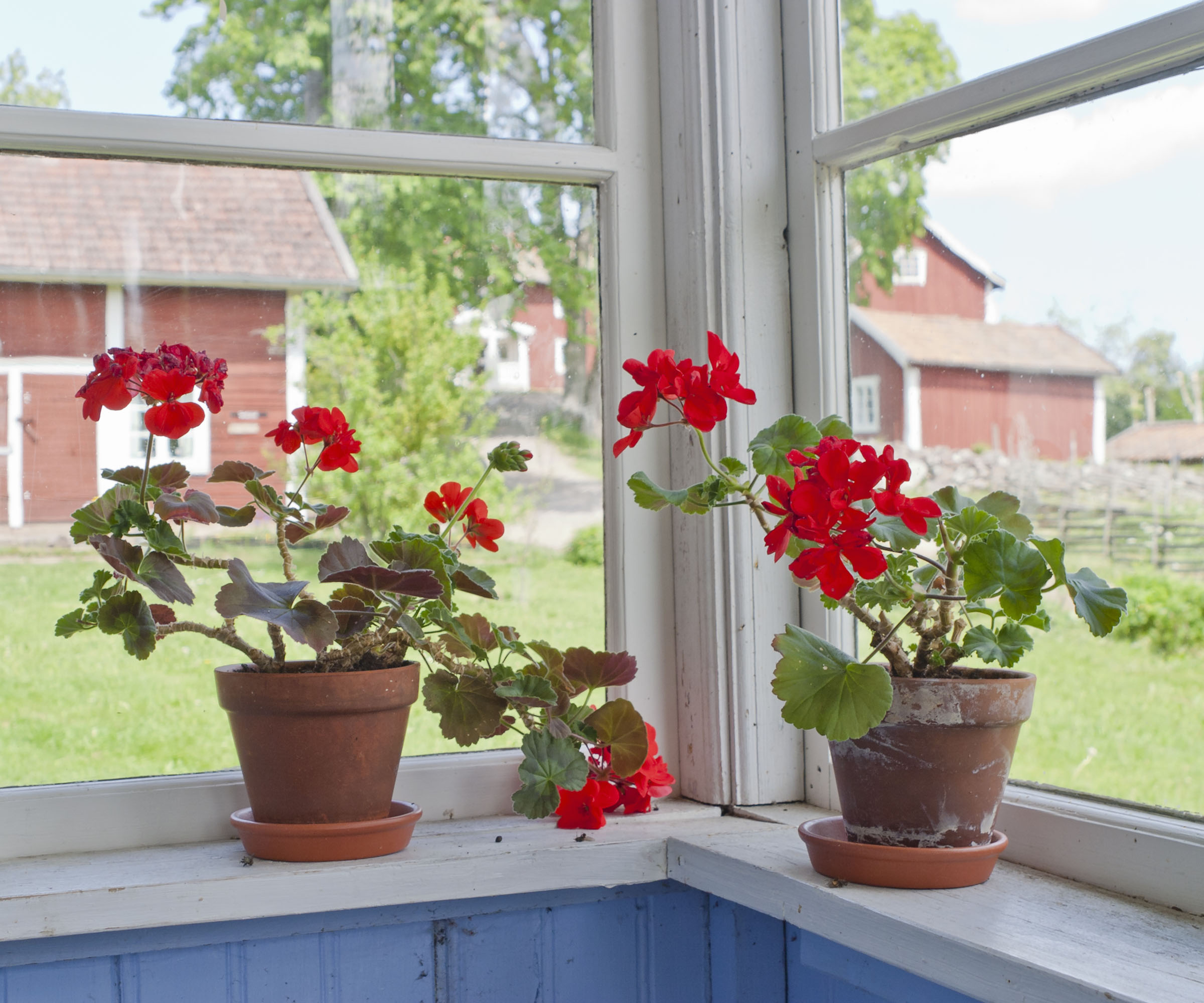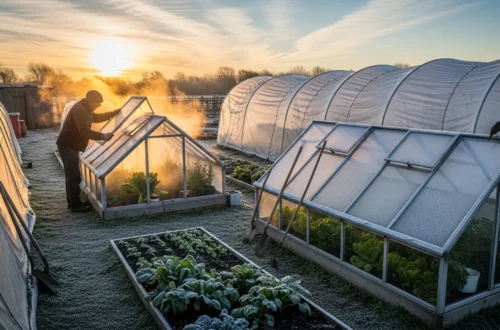Table of Contents
Table of Contents
Introduction
Gardening has always been a blend of patience, creativity, and care. But in 2025, the way we grow and maintain our gardens is being transformed by technology. From AI gardening tools that can detect plant diseases instantly to smart gardening devices for small spaces, the future of gardening is smarter, greener, and more accessible than ever before.
This guide is your ultimate resource on how artificial intelligence and smart devices are reshaping gardening. We’ll explore the best AI gardening tools for 2025, how robotic gardening tools are changing the way we maintain our outdoor spaces, and why eco-friendly smart gardening tools are becoming essential for sustainable living. Whether you’re a beginner with a balcony garden or a seasoned grower with a backyard plot, this guide will show you how to garden smarter—not harder.
As technology continues to merge with everyday living, Smart Gardening Tools are no longer a luxury—they’re becoming a necessity for gardeners who want efficiency, precision, and sustainability. Imagine a garden where sensors tell you exactly when your plants need water, AI apps diagnose diseases before they spread, and robotic devices handle the tedious chores of mowing or weeding. These innovations are not just futuristic concepts; they are available now and rapidly evolving in 2025. By embracing these tools, gardeners can save time, reduce waste, and achieve healthier, more vibrant gardens with less guesswork.
This guide will walk you through the most impactful Smart Gardening Tools of 2025, from compact devices designed for small urban spaces to advanced AI-powered systems that transform entire backyards. Along the way, you’ll discover how these tools are reshaping gardening for beginners and experts alike, making it easier to grow food, care for plants, and contribute to a more eco-friendly lifestyle. By the end, you’ll not only understand the latest trends but also know exactly which tools can help you garden smarter, not harder.
Why AI is Transforming Gardening in 2025
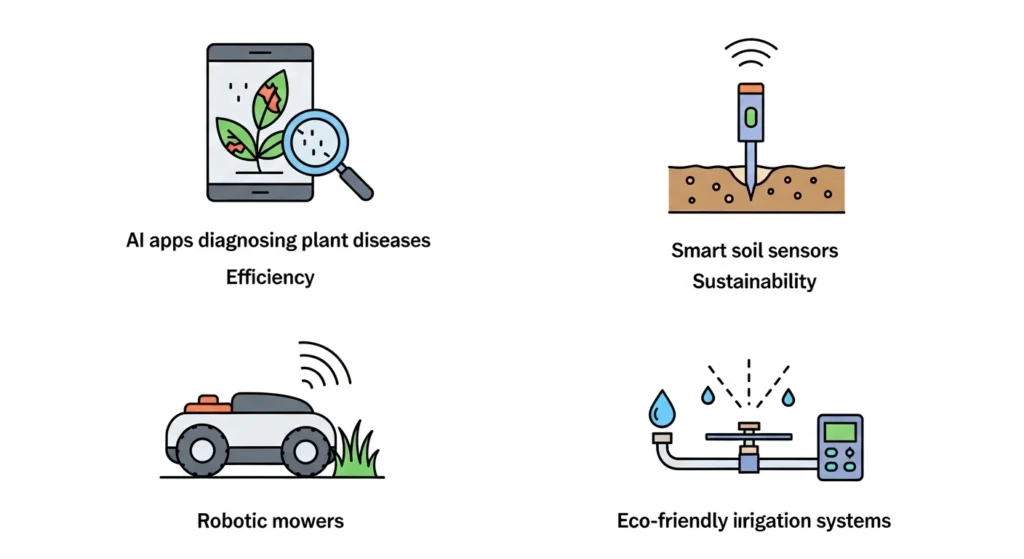
In 2025, the gardening world is experiencing a shift unlike anything before. What was once a purely manual practice is now being enhanced by Smart Gardening Tools that combine artificial intelligence, sensors, and automation to create a more efficient and sustainable experience. These tools are not replacing the joy of gardening but amplifying it—helping gardeners make better decisions, reduce waste, and achieve healthier results with less effort. From AI-powered apps that diagnose plant diseases to robotic devices that handle repetitive tasks, the integration of technology is redefining what it means to be a modern gardener.
The appeal of Smart Gardening Tools lies in their ability to simplify complex processes. Instead of guessing when to water, fertilize, or prune, gardeners can now rely on data-driven insights that adapt to their unique environment. This means fewer mistakes, stronger plants, and more time to enjoy the creative side of gardening. For beginners, these tools act as a personal coach, while for experienced growers, they provide precision and efficiency that was once only available to large-scale farms. This democratization of technology is why AI is not just a passing trend—it’s becoming the backbone of gardening in 2025 and beyond.
The Rise of AI in Home & Urban Gardening
Artificial intelligence is no longer confined to large-scale agriculture. In 2025, AI gardening tools will be designed for everyday gardeners. Apps can now identify plant diseases, recommend treatments, and even suggest the best time to water based on hyper-local weather data.
Urban gardeners, in particular, are benefiting from AI. With limited space, they need smart gardening devices for small spaces—compact planters, automated watering systems, and AI grow lights that maximize yield without requiring constant attention.
Benefits of AI for Beginners and Professionals
- Beginners: AI apps act like a personal gardening coach, guiding you step by step.
- Professionals: Smart sensors and AI irrigation systems optimize water use, saving both money and resources.
- Everyone: Robotic tools reduce repetitive tasks like mowing and weeding, freeing up time for the creative side of gardening.
Sustainability and Eco-Friendly Smart Gardening Tools
One of the biggest advantages of AI in gardening is its impact on sustainability. Eco-friendly smart gardening tools help reduce water waste, minimize chemical use, and promote healthier soil. For example, AI irrigation systems for home gardens can cut water usage by up to 30% compared to traditional methods (EPA – Water Conservation).
🌟 Top AI Gardening Tools for 2025
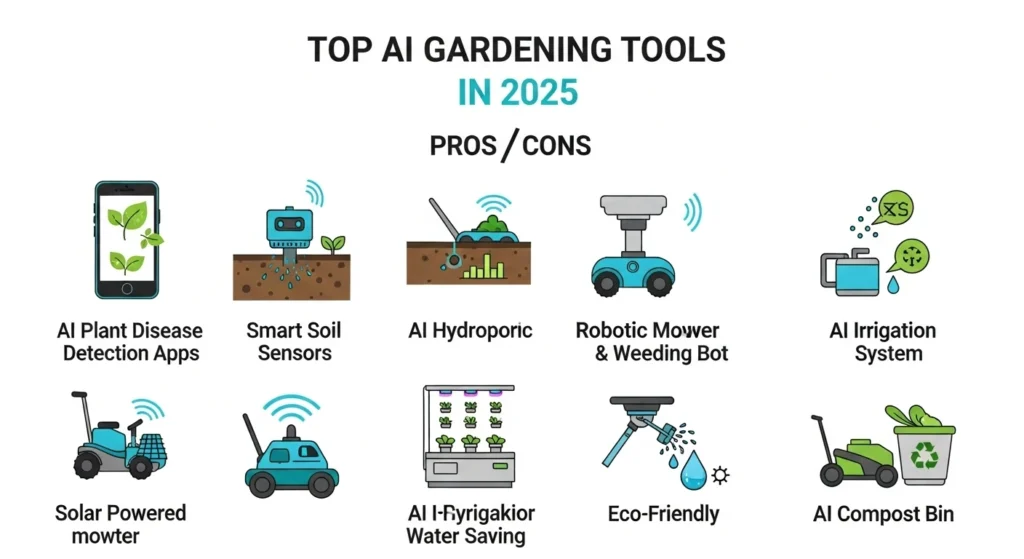
The year 2025 is shaping up to be a turning point for Smart Gardening Tools. No longer niche gadgets, these devices are becoming mainstream, helping gardeners save time, reduce waste, and achieve professional-level results at home. Below is a breakdown of the most impactful categories of AI gardening tools available this year, complete with comparisons, benefits, and considerations.
1. AI-Powered Plant Disease Detection Apps
Keywords: AI plant disease detection app, smart gardening tools
These apps use AI image recognition to identify plant problems instantly. By snapping a photo, gardeners can detect fungal infections, nutrient deficiencies, or pest infestations. Popular examples include Plantix
and PictureThis.
- Examples: Plantix, PictureThis, and newer 2025 AI-driven startups
- Pros:
- Instant diagnosis
- Beginner-friendly
- Reduces crop loss
- Cons:
- Requires a smartphone and internet access
- Accuracy depends on photo quality
- Best For: Beginners who want quick answers without consulting experts
Comparison: Traditional gardening books vs. AI apps → Apps provide real-time, personalized insights, while books offer general guidance (Royal Horticultural Society).
2. Smart Soil Sensors & Nutrient Monitors
Keywords: smart gardening devices, AI gardening tools 2025
Soil health is the foundation of gardening, and smart soil sensors are revolutionizing how we monitor it. These devices track moisture, pH, and nutrient levels, then send data to your phone. For example, the Gardena Smart Sensor is widely used in 2025.
- Examples: Xiaomi Smart Soil Sensor, Gardena Smart Sensor, 2025 AI-integrated models
- Pros:
- Prevents overwatering
- Optimizes fertilizer use
- Data-driven insights
- Cons:
- Higher upfront cost
- Requires calibration for accuracy
- Best For: Gardeners who want precision and eco-friendly practices
Comparison: Manual soil testing kits vs. AI sensors → Kits are cheaper but less accurate; sensors provide continuous monitoring (University of California Agriculture & Natural Resources).
3. Robotic Lawn Mowers & Weeding Bots
Keywords: robotic gardening tools 2025, smart gardening tools
Robotics are no longer futuristic—they’re here. Robotic mowers keep lawns trimmed, while AI-powered weeding bots identify and remove weeds without harming crops.
- Examples: Husqvarna Automower, Tertill Weeding Robot, new solar-powered models in 2025
- Pros:
- Saves time and labor
- Eco-friendly (solar-powered options)
- Reduces chemical herbicide use
- Cons:
- Expensive upfront investment
- May struggle on uneven terrain
- Best For: Busy homeowners with medium to large gardens
Comparison: Manual mowing vs. robotic mowing → Robots save hours weekly, but manual mowing is cheaper.
4. AI-Driven Hydroponic & Vertical Gardening Systems
Keywords: smart gardening devices for small spaces, AI gardening tools 2025
For urban gardeners, AI hydroponic systems are game-changers. They automate nutrient delivery, lighting, and watering, making it possible to grow vegetables indoors year-round.
- Examples: Aero Garden Bounty Elite, Click & Grow Smart Garden, 2025 AI-integrated vertical farms
- Pros:
- Space-efficient
- High yield in small areas
- Year-round growing
- Cons:
- Requires electricity
- Higher learning curve
- Best For: Apartment dwellers, balcony gardeners, and small-space growers
Comparison: Traditional soil gardening vs. AI hydroponics → Soil is natural and low-cost, but hydroponics offers higher yields in limited space.
5. AI Irrigation Systems for Home Gardens
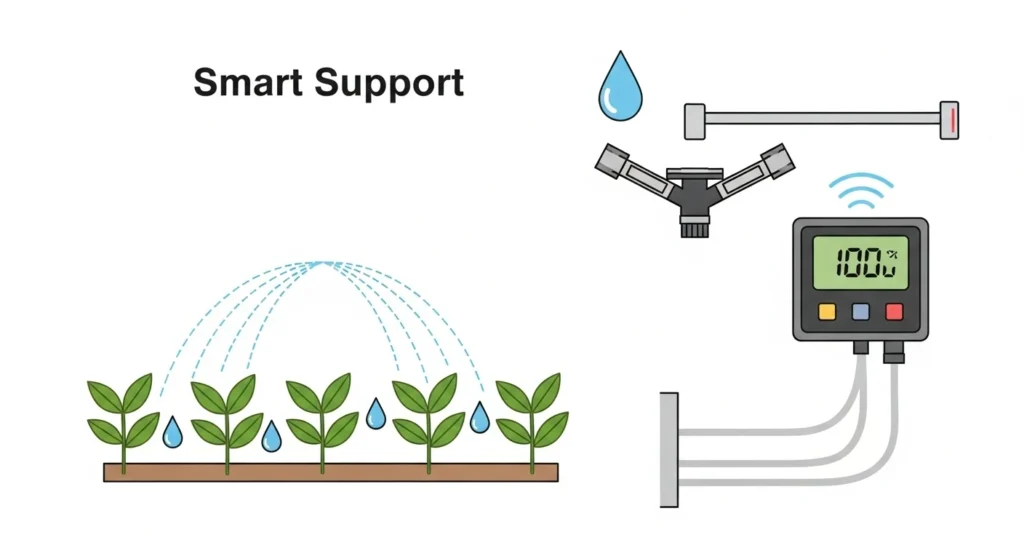
Keywords: AI irrigation system for home gardens, eco-friendly smart gardening tools
Watering is one of the most common gardening challenges. AI irrigation systems use weather forecasts, soil data, and plant needs to deliver water only when necessary.
- Examples: Rachio Smart Irrigation, Netro Sprite, 2025 AI-enhanced models
- Pros:
- Saves up to 30% water
- Reduces utility bills
- Eco-friendly
- Cons:
- Requires Wi-Fi and setup
- The initial cost is higher than drip systems
- Best For: Gardeners in dry climates or those seeking sustainability
Comparison: Traditional drip irrigation vs. AI irrigation → Drip is reliable but static; AI adapts in real time.
6. Eco-Friendly Smart Gardening Tools
Keywords: eco-friendly smart gardening tools, sustainable AI gardening
Sustainability is at the core of 2025’s gardening innovations. From solar-powered robotic mowers to AI composting systems, eco-friendly tools are helping gardeners reduce their environmental footprint.
- Examples: SolarBot Mower, SmartCompost AI Bin
- Pros:
- Reduces waste
- Promotes sustainability
- Long-term cost savings
- Cons:
- Limited availability in some regions
- Higher upfront costs
- Best For: Eco-conscious gardeners
Comparison: Traditional compost bins vs. AI composting → AI bins are faster and more efficient, while traditional bins are cheaper but slower.
📊 Quick Comparison Table
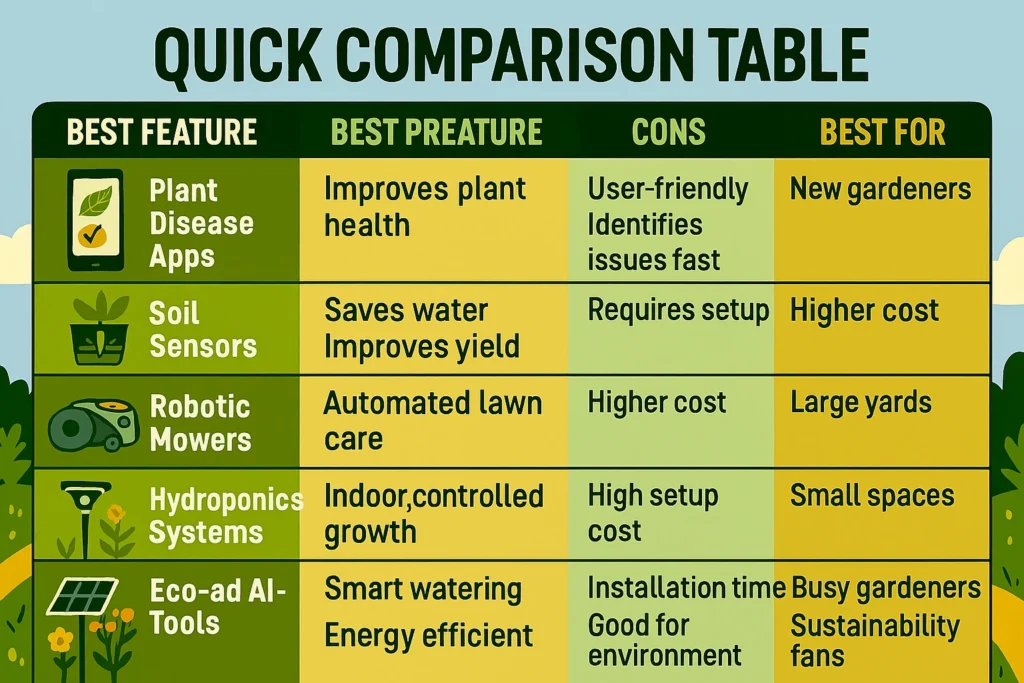
| Tool Type | Best Feature | Pros | Cons | Best For |
|---|---|---|---|---|
| AI Plant Disease Apps | Instant diagnosis | Fast, beginner-friendly | Needs smartphone | Beginners |
| Smart Soil Sensors | Real-time soil data | Precision, eco-friendly | Higher cost | Data-driven gardeners |
| Robotic Mowers/Weeders | Automation | Saves time, eco-friendly | Expensive | Busy homeowners |
| AI Hydroponics | Indoor growing | Space-efficient, high yield | Needs electricity | Urban gardeners |
| AI Irrigation Systems | Adaptive watering | Saves water, eco-friendly | Setup required | Sustainability-focused |
| Eco-Friendly Tools | Green innovation | Reduces waste | Limited availability | Eco-conscious gardeners |
🌿 Smart Gardening Devices for Small Spaces
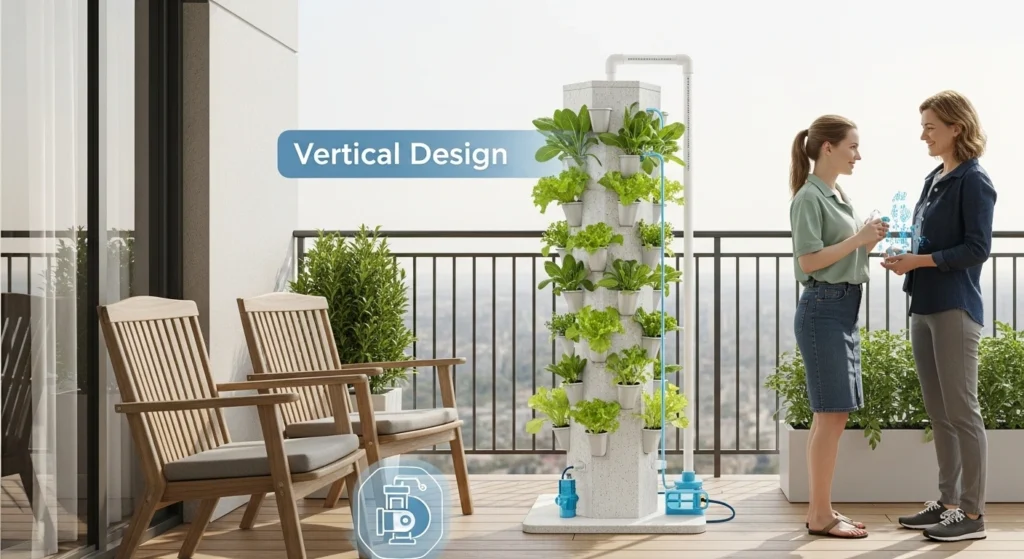
Urban living often means limited gardening space, but in 2025, Smart Gardening Tools are making it possible to grow lush, productive gardens even in apartments and balconies. These compact devices combine AI, automation, and space-saving design to maximize yield without requiring large plots of land.
Compact Smart Planters with AI Watering Systems
- Examples: Click & Grow Smart Garden 9, Xiaomi Smart Planter, 2025 AI-integrated balcony planters
- Pros:
- Automated watering schedules
- Monitors soil moisture and nutrients
- Perfect for herbs, lettuce, and small vegetables
- Cons:
- Limited plant capacity
- Requires electricity or batteries
- Best For: Apartment dwellers who want a low-maintenance indoor garden
Comparison: Traditional pots vs. AI smart planters → Pots are cheaper but require manual care; smart planters automate the process and reduce mistakes.
Balcony-Friendly Hydroponic Kits
- Examples: AeroGarden Harvest Slim, Rise Gardens Personal Hydroponic Kit
- Pros:
- Space-efficient vertical design
- Year-round growing indoors
- AI-controlled nutrient and light cycles
- Cons:
- Higher upfront cost
- Needs regular cleaning
- Best For: Urban gardeners who want fresh produce without outdoor space
Comparison: Soil-based balcony gardening vs. AI hydroponics → Soil is traditional but limited in yield; hydroponics offers faster growth and higher productivity.
AI Grow Lights for Indoor Gardening
- Examples: Mars Hydro AI Grow Light, Philips Hue Plant Spectrum 2025
- Pros:
- Adjusts spectrum and brightness automatically
- Energy-efficient LED technology
- Supports plant growth in low-light apartments
- Cons:
- Requires setup and calibration
- Electricity costs add up
- Best For: Indoor gardeners with limited natural light
Comparison: Standard LED grow lights vs. AI grow lights → Standard LEDs are static; AI grow lights adapt to plant growth stages for better results.
🌍 Eco-Friendly Smart Gardening Tools
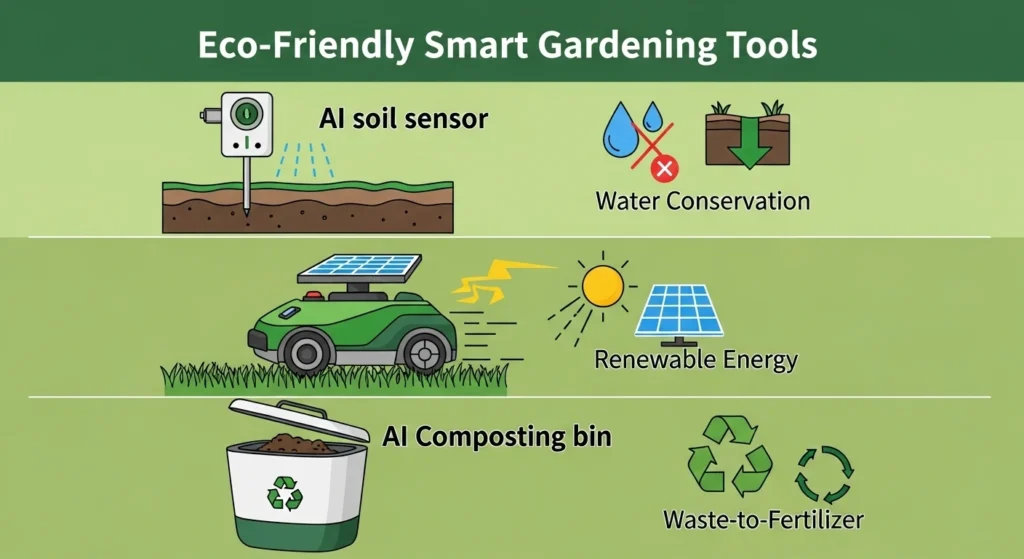
Sustainability is no longer optional—it’s essential. In 2025, eco-friendly Smart Gardening Tools are helping gardeners reduce their environmental footprint while still enjoying the benefits of technology. These tools combine AI with renewable energy and sustainable practices to create greener gardens (MIT Technology Review – AI & Sustainability).
Reducing Water Waste with AI Sensors
- Examples: Netro Whisperer AI Soil Sensor, Gardena Smart Sensor 2025
- Pros:
- Cuts water usage by up to 30%
- Prevents overwatering and root rot
- Supports eco-friendly gardening practices
- Cons:
- Requires Wi-Fi and app integration
- The initial investment is higher than the manual methods
- Best For: Gardeners in water-scarce regions or eco-conscious households
Comparison: Manual watering vs. AI sensors → Manual watering risks waste; AI ensures precision and conservation.
Solar-Powered Robotic Gardening Tools
- Examples: Husqvarna Solar Automower, Tertill Solar Weeding Robot
- Pros:
- Runs on renewable solar energy
- Reduces reliance on fossil fuels
- Low maintenance once installed
- Cons:
- Limited performance in shaded areas
- Higher upfront cost
- Best For: Eco-conscious gardeners with medium to large outdoor spaces
Comparison: Electric robotic mowers vs. solar-powered → Electric requires charging; solar-powered runs independently with sunlight.
AI Composting & Waste Management Systems
- Examples: SmartCompost AI Bin, Lomi AI-Powered Composter 2025
- Pros:
- Accelerates composting with AI monitoring
- Reduces food and garden waste
- Produces nutrient-rich compost faster
- Cons:
- Requires electricity
- More expensive than traditional bins
- Best For: Gardeners who want sustainable waste management and organic fertilizer
Comparison: Traditional compost bins vs. AI composting → Traditional bins are cheaper but slower; AI bins are faster, cleaner, and more efficient.
Why How AI Helps Beginners Garden Smarter
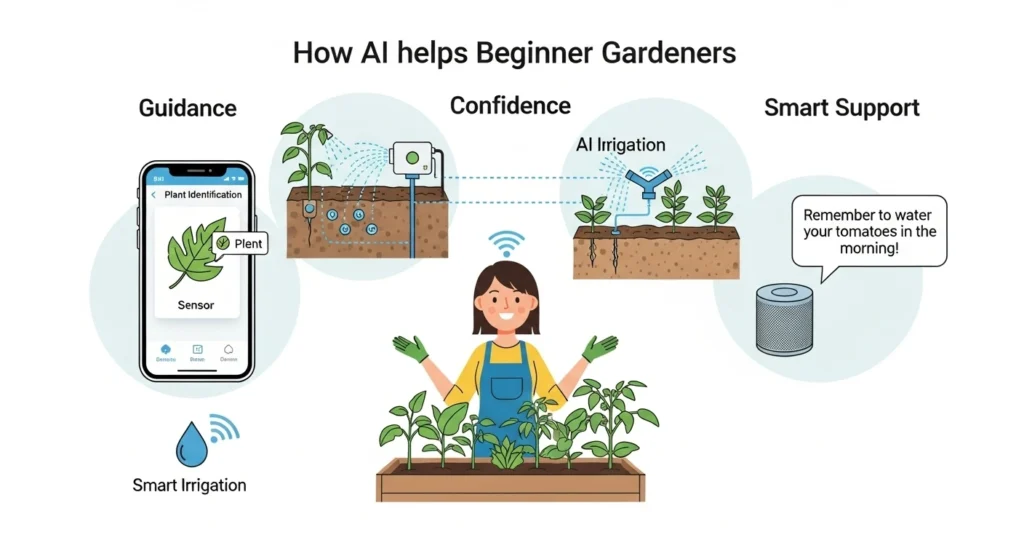
For new gardeners, the learning curve can feel overwhelming—when to water, how much sunlight is enough, or how to deal with pests. This is where Smart Gardening Tools step in as a reliable partner. Instead of relying on trial and error, beginners can use AI-powered apps, sensors, and devices that provide real-time feedback tailored to their specific plants and environment. These tools act like a personal gardening coach, guiding users through each stage of growth and helping them avoid common mistakes that often discourage first-time gardeners.
What makes Smart Gardening Tools especially valuable for beginners is their ability to simplify complex gardening tasks into easy, actionable steps. An AI irrigation system, for example, doesn’t just water plants—it learns from soil conditions, weather forecasts, and plant needs to deliver the right amount of water at the right time (Smart Watering – Rachio). Similarly, plant disease detection apps can prevent small issues from becoming major problems, giving new gardeners the confidence to keep going. By removing uncertainty and providing clear direction, these tools transform gardening from a guessing game into a rewarding, confidence-building experience.
AI Apps That Identify Plants & Diseases
Apps like Plantix and PictureThis are evolving with AI, offering instant plant identification and care tips.
Personalized Gardening Recommendations with AI
AI platforms now provide tailored advice based on your location, soil type, and gardening goals.
Voice Assistants & Chatbots for Gardening Tips
Smart assistants like Alexa and Google Home integrate with gardening apps, allowing you to ask questions like:
- “When should I water my basil?”
- “What’s wrong with my tomato plant?”
The Future of Gardening with AI (Beyond 2025)
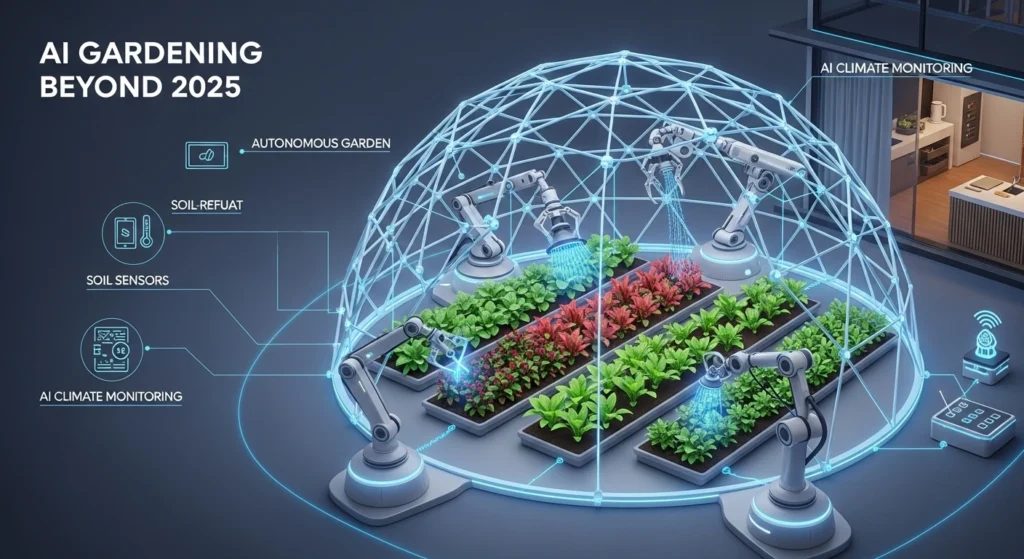
The innovations we see in Smart Gardening Tools today are only the beginning. As AI continues to evolve, the next decade will bring even more advanced integrations between technology and nature. By 2030, we can expect fully autonomous gardens that manage themselves—watering, fertilizing, and even harvesting without human intervention (IEEE Spectrum – Robotics in Agriculture). These systems will not only save time but also ensure optimal plant health by constantly learning and adapting to environmental changes.
Another exciting development is the integration of smart homes with smart gardens. Imagine a future where your home assistant doesn’t just adjust the thermostat but also communicates with your garden. It could dim your AI grow lights in the evening, adjust irrigation based on your water usage goals, and even notify you when your tomatoes are ready to harvest. This seamless connection between living spaces and green spaces will redefine what it means to live sustainably.
Looking further ahead, AI will also play a role in climate-resilient gardening. With unpredictable weather patterns, gardeners will rely on AI-driven seed selection, soil optimization, and predictive analytics to grow crops that can withstand heatwaves, droughts, or heavy rains. These advancements will empower everyday gardeners to contribute to global food security while maintaining eco-friendly practices.
Ultimately, the future of gardening with AI is about balance—using technology not to replace the joy of gardening, but to enhance it. By 2030 and beyond, Smart Gardening Tools will be less about gadgets and more about creating ecosystems where humans, plants, and technology thrive together.
AI + Robotics in Sustainable Farming
Expect to see more crossover between home gardening and commercial agriculture, with AI tools designed for both.
Smart Homes Integrating with Smart Gardens
In the near future, your smart home system could sync with your garden—adjusting irrigation, lighting, and even harvesting schedules.
Predictions for 2030 and Beyond
- Fully autonomous gardens that manage themselves
- AI-driven seed selection for climate resilience
- Integration of gardening with health apps to track nutrition
How to Choose the Right AI Gardening Tool for You
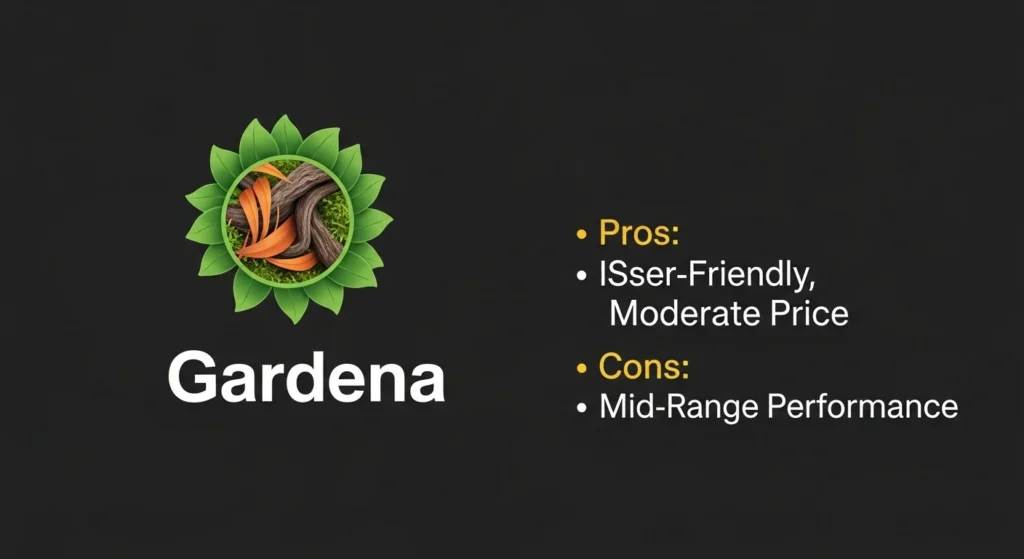
Factors to Consider
- Budget: Entry-level vs. premium tools
- Garden Size: Balcony vs. backyard
- Goals: Food production, aesthetics, or sustainability
Comparing Top Brands & Startups
Established brands like Husqvarna and Gardena are competing with startups offering niche AI solutions.
Where to Buy AI Gardening Tools in 2025
- Online marketplaces (Amazon, specialized gardening stores)
- Direct from manufacturers
- Local smart home retailers
Conclusion
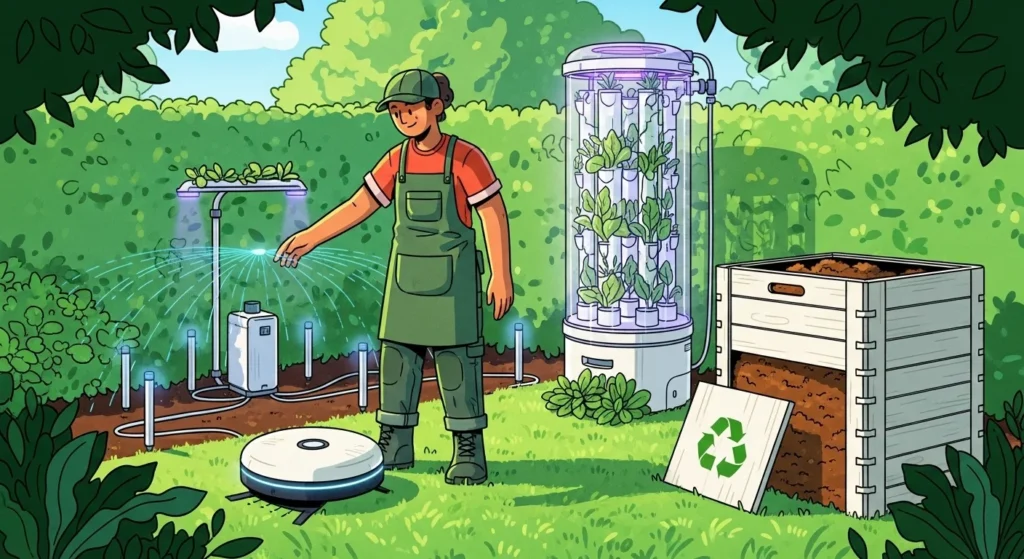
The journey into the world of Smart Gardening Tools is more than just a look at gadgets—it’s a glimpse into the future of how we connect with nature. In 2025 and beyond, gardening is no longer limited by space, time, or guesswork. With AI-powered apps, robotic helpers, and eco-friendly devices, anyone can create a thriving garden that reflects both modern innovation and timeless care for the earth. These tools don’t replace the joy of gardening; they amplify it, giving beginners confidence and experts precision.
By embracing Smart Gardening Tools, you’re not just upgrading your garden—you’re investing in sustainability, efficiency, and a lifestyle that balances technology with nature. Whether you’re tending a balcony herb garden or managing a backyard oasis, the tools of today are paving the way for the gardens of tomorrow.
As we’ve seen throughout this guide, AI is transforming every aspect of gardening: from disease detection and irrigation to composting and climate resilience. The future promises even more—autonomous gardens, smart home integration, and climate-adaptive solutions that will redefine what it means to grow.
So, the next time you water your plants or check on your soil, imagine what’s possible when you let technology lend a hand. The future of gardening is here, and with the right Smart Gardening Tools, it’s greener, smarter, and more rewarding than ever.
❓ Frequently Asked Questions (FAQs)
Q1: What are Smart Gardening Tools?
Smart Gardening Tools are AI-powered or automated devices designed to make gardening easier, more efficient, and sustainable. They include soil sensors, irrigation systems, plant disease detection apps, robotic mowers, and hydroponic kits that use data and automation to optimize plant care.
Q2: What is the best Smart Gardening Tool in 2025?
The “best” tool depends on your needs. For beginners, AI plant disease detection apps are invaluable. For small-space gardeners, compact hydroponic kits and AI grow lights are ideal. For larger gardens, robotic lawn mowers and AI irrigation systems save time and resources.
Q3: Can Smart Gardening Tools really detect plant diseases?
Yes. Modern AI plant disease detection apps use image recognition to identify common issues like fungal infections, nutrient deficiencies, or pest damage. By simply taking a photo of a leaf, gardeners can get instant, accurate diagnoses and recommended treatments.
Q4: Are Smart Gardening Tools worth it for small spaces?
Absolutely. Many smart gardening devices for small spaces—like balcony-friendly hydroponic kits and AI-powered planters—are designed specifically for apartments and urban living. They maximize yield in limited areas and automate care, making gardening accessible to everyone.
Q5: How much do Smart Gardening Tools cost in 2025?
Prices vary widely. Entry-level AI irrigation systems or soil sensors can start around $100–$200, while advanced robotic gardening tools may cost $1,000 or more. However, many gardeners find the investment worthwhile due to water savings, reduced labor, and healthier plants.
Q6: Are eco-friendly Smart Gardening Tools really sustainable?
Yes. Many eco-friendly Smart Gardening Tools are designed to reduce water waste, minimize chemical use, and run on renewable energy like solar power. AI composting systems also help recycle food and garden waste into nutrient-rich fertilizer, supporting sustainable gardening practices.
Q7: Will Smart Gardening Tools replace traditional gardening methods?
Not at all. These tools are meant to enhance gardening, not replace it. They reduce guesswork and repetitive tasks, allowing gardeners to focus on creativity, design, and the joy of growing. Traditional methods still matter, but Smart Gardening Tools make them more efficient.

